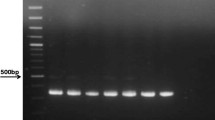Abstract.
Background: TT virus (TTV) DNA has been found in a large proportion of patients with different forms of non-A-G hepatitis, however the clinical importance is unclear. We aimed to determine the genotypes of TTV isolates foung in blood donors and different patient groups from the western part of Turkey.
Materials and Methods: TT DNA was investigated in serum samples of 91 volunteer blood donors (BD), 105 thalassemia (TH) patients, ten patients with fulminant hepatitis (FH) and 16 hemodialysis (HD) patients by heminested PCR using primers NG059, NG061 and NG063 from the ORF1 region. 39 isolates were genotyped by analyzing the partial sequence of ORF1.
Results: TTV DNA was found in 75% of HD, 80% of FH, 61% of TH patients and in 51.6% of BD. Among the sequenced isolates, 14 (35.9%) belonged to genotype 1 (G1) and 25 (64.1%) belonged to genotype 2 (G2). Among the G2 sequences, 22 were grouped as G2c.
Conclusion: TTV infection was common in the population studied, even with moderately sensitive primers. G2 was the major genotype of the studied population without any significant differences in distribution between various patient groups and BD.
Similar content being viewed by others
Author information
Authors and Affiliations
Additional information
Received: December 27, 2001 · Revision accepted: April 4, 2002
S. Erensoy (corresponding author)
Rights and permissions
About this article
Cite this article
Erensoy, S., Sayıner, A., Türkoğlu, S. et al. TT Virus Infection and Genotype Distribution in Blood Donors and a Group of Patients from Turkey. Infection 30, 299–302 (2002). https://doi.org/10.1007/s15010-002-2185-z
Issue Date:
DOI: https://doi.org/10.1007/s15010-002-2185-z




